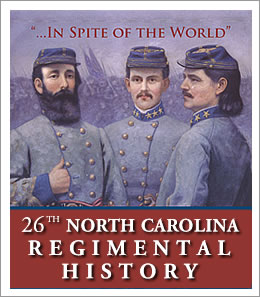
A BRIEF REGIMENTAL HISTORY
The 26th Regiment - North Carolina Troops was organized from companies raised from the middle and western portions of the "Old North State". Originally commanded by Zebulon Baird Vance, who later became North Carolina's wartime governor, the regiment first saw action at New Bern, N.C. in March 1862. Here they attempted to resist an assault by forces of Union General Ambrose Burnside. After this action, the regiment went north to Virginia and soon distinguished itself in battle. During a portion of the Seven Days' Battle, at Malvern Hill, the 26th charged to within 25 five yards of the Federal positions, further encouraging McClellan's departure from the York-James Peninsula. Upon returning to eastern North Carolina, the unit helped keep Union forces located there in check, protecting the "back door" to Richmond and the vital supplies coming from Wilmington to the Confederate capital.
Returning to service in Virginia again in 1863, the regiment was attached to Robert E. Lee's Army of Northern Virginia. Moving into Pennsylvania with the ANV, the gallant 26th saw action at Gettysburg in Pettigrew's Brigade, Heth's Division, Hill's Corps. On 1 July 1863, the 26th would forever etch its name in history.
On this first day of the Battle of Gettysburg, the regiment was called upon to assault Federal troops of the Iron Brigade (specifically the 24th Michigan) posted in Herbst's woods on McPherson's Ridge. After brutal fighting, which saw the 26th break through three separate lines of resistance, the regiment forced Union troops to withdraw from the position of strength which they had held. Though the 26th achieved its goal, it was at a tremendous cost. The regimental colors were shot down fourteen times; the regimental commander Colonel Henry King Burgwyn, Jr., was killed; and his second-in-command, Lt. Col. John R. Lane, was seriously wounded. Out of 800 muskets taken into the fight by the 26th on that bloody day, 588 men were killed, wounded, or missing. Sidelined to regroup and tend their significant number of wounded, the regiment rested on July 2nd on the slopes of Seminary Ridge.
On July 3rd, the 26th participated in the Pettigrew-Trimble-Pickett Assault against the center of the Federal line on Cemetery Hill. Having the colors shot down eight more times, the regiment planted its colors on the Federal works -- The Angle -- achieving the farthest advance of any Confederate unit during this epic struggle. On 3 July, the unit lost an additional 120 men. The regiment suffered greatly during this three-day bloodletting. Company F, The Hibriten Guards, suffered a 100 percent loss with all of its ninety one men and officers being killed or wounded. The 26th holds the tragic distinction of suffering the highest casualties of any unit, Confederate or Union, during the Battle of Gettysburg.
The Wilderness was the next major battle in which the regiment saw action. Again, the regiment was with the corps commanded by A.P. Hill, and it figured prominently in the outcome of the contest. With the battle wavering on the Confederate right, the 26th was thrown into the fight with the remainder of Hill's Corps to save the day.
The regiment next participated in the defense of Petersburg. For nearly one and one half years, the 26th bolstered the Confederate forces in the area and stalled the Union forces under Grant around Richmond and Petersburg. The result of this stubborn resistance was that the Southern Nation continued to live on and struggle to survive despite the constant and vicious frontal assaults of the north.
With the War Between the States drawing to a close, the regiment continued its service with the Army of Northern Virginia and surrendered with Gen. Lee at Appomattox Courthouse on 9 April 1865.
For more indepth informattion, see the full Regimental History
link at the top right of this page







